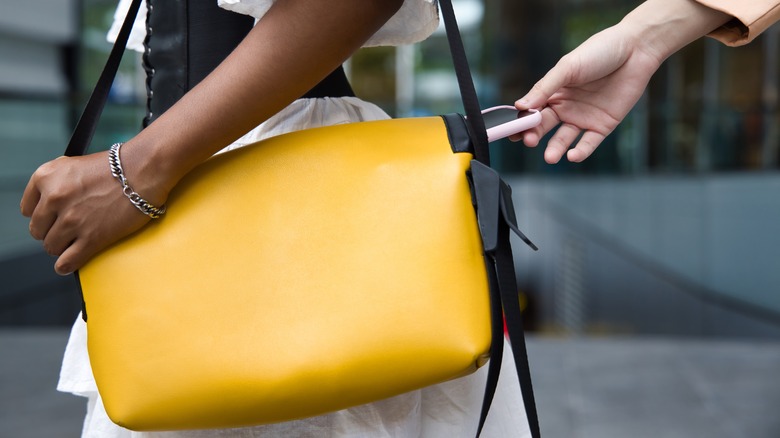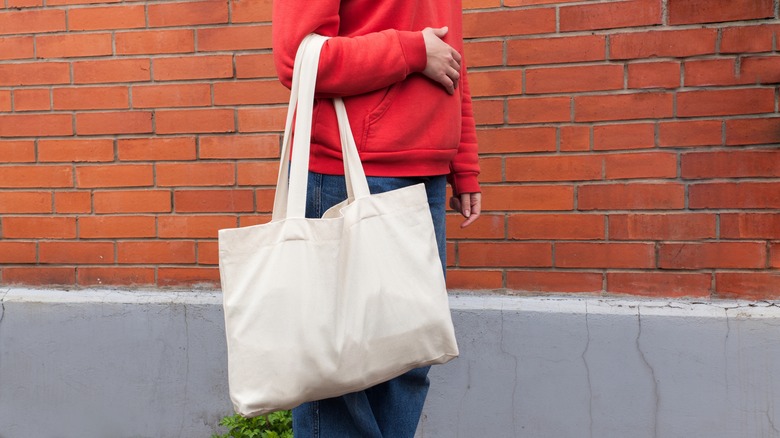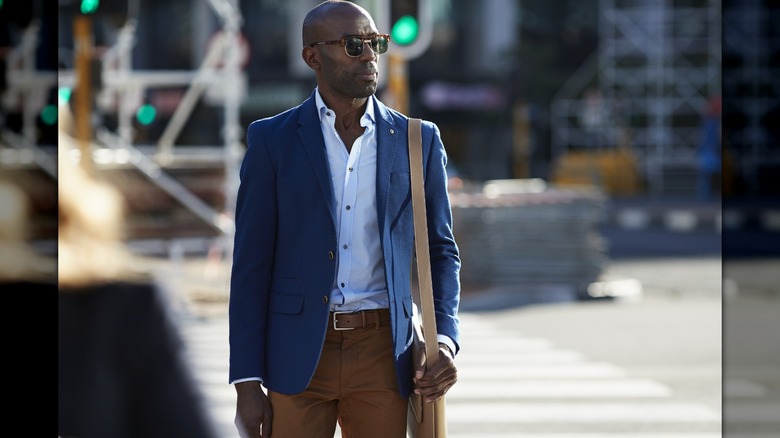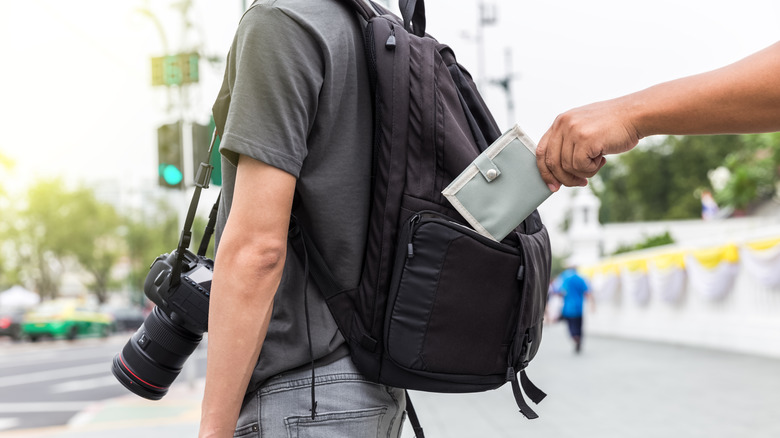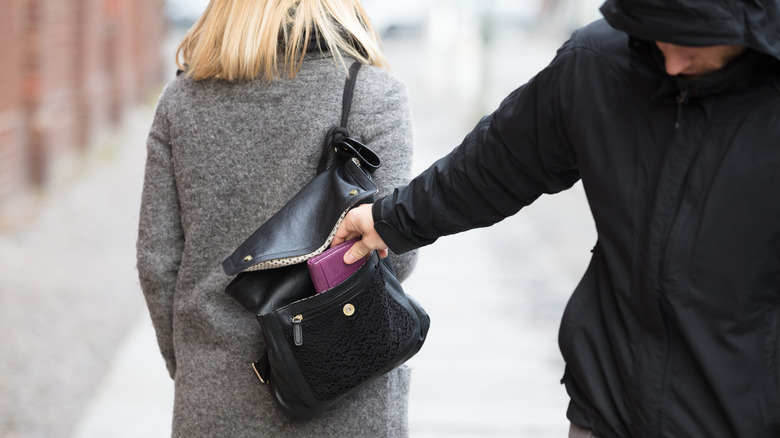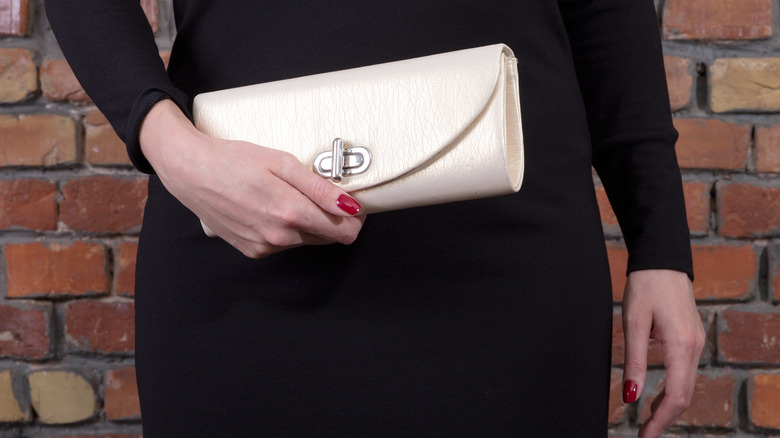The 5 Types Of Purses And Bags Pickpocketers Steal From The Most
We may receive a commission on purchases made from links.
What is it like to be pickpocketed? You lose valuable items at an extremely inconvenient time. Pickpocketers frequently target tourists who aren't paying attention and often carry their wallets, phones, or even their passports. When traveling, these items are hard to replace, leading to a logistical nightmare. However, the trauma of being robbed goes far beyond damage control. It's a personal violation — and not being aware of the incident leaves you with a creepy feeling.
If you've never been pickpocketed, we hope it stays that way. But if you have, you like want to avoid a repeat at all costs. Luckily, you don't need to be on constant alert or feel paranoid. You just need to take the right precautions and we have just the hacks to protect you from pickpocketers.
For starters, don't make it easy. One of the best lines of defense is avoiding certain purses and bags. Pickpockets scan crowds, looking for bags with easy entry. The whole point is to get away undetected, so if they can gently lift items without evoking suspicion, they've succeeded (and will be long gone by the time you notice). So which bags are we referring to? Keep reading to learn what bags and purses pickpockets love and what makes each an ideal target.
Open-top tote bags
Tote bags are a trendy alternative to the standard purse or backpack. These mid-to-large-sized bags have two parallel handles and an open pouch. They are available in a variety of fabrics and price points, from economic canvas options to designer leather ones. With their convenient size and shape, you can sling one over your shoulder for a quick shopping trip or pack one with everything you need for a sightseeing day.
Unfortunately, what makes them so easy to use is also what makes them easy to pickpocket: the open-top, one-shoulder design. Think about it. You're standing on a crowded subway, a tote bag resting on your shoulder, with half the bag peeking out behind you. The open top leaves just enough room for a pickpocketer to slide a hand inside and help themselves to whatever's available. Since these bags are loose, you might not feel the intrusion. And at the next subway stop, the thief can make a quick getaway.
Save the tote bags for low-risk destinations, or pack them solely with non-valuable items. Fill your tote with towels and snacks for the beach or use it to carry groceries. As far as valuables go, we recommend carrying these precious items on the front of your body in a zipped bag like a crossbody purse or fanny pack.
Shoulder bag
A shoulder bag is just as it sounds: a bag that's worn over one shoulder rather than across your body. Unlike tote bags, shoulder bags have one long strap. While they can have an open top, they're often covered by a flap or even a zip. They also tend to have more detailed design elements, like side pockets. Some laptop bags also fit this criteria. Shoulder bags are comfortable in that you can toss them on and off your shoulder. But because this bag hangs so loosely by your side, you're unlikely to notice when someone is tampering with it.
When traveling, closed-top designs are always preferable. However, an experienced thief is still skilled at unzipping or lifting flaps and snatching what's inside. Also, people generally use the easily accessible side pockets for cell phones and wallets. But if you come in close contact with an opportunistic pickpocket, you can say ta-ta to that telephone. And if they're particularly bold, they might pull the bag off your shoulder and run away with the whole thing.
Backpacks
People mistakenly assume backpacks are safe when traveling. However, we'd think twice before strapping on a backpack for a day of sightseeing. They do store a decent amount, making them perfect for day trips, and with different compartments and zippers, it's ideal to keep things organized. However, as the name suggests, they are obviously worn on your back, making them vulnerable to pickpockets.
Similar to shoulder bags, most backpacks have both outside and side pockets where people are likely to store their most-used items. If the side pockets are mesh bottle holders, definitely avoid placing items here. It's basically an advertisement to pickpocketers of what could be theirs. Since backpacks are bulkier, you also need to take them off to sit down. Just be careful not to get too settled with that backpack by your side. If you're not in a secure location, a thief could pull a grab-and-go in seconds.
To keep your backpack safe, we suggest wearing it on the front of your body in crowded or theft-prone areas. When sitting down at restaurants, place it under your chair and put one of the chair legs through a strap. If a thief tries to steal it, they'll have to take you along with it.
Flap bag
A flap bag or purse can be cross-bodied or one-shouldered and is covered on top by an elegant fold. This flap seals shut with a magnet, a button, or a latch closure. Although this sounds like a solid security measure, a skilled pickpocketer has plenty of experience opening these closures without a sound. Even if the latch does click open, you wouldn't hear it in a busy bar or noisy street.
Flap bags, particularly of the purse variety, are extremely common. More often than not, thieves train themselves to open a specific type of bag without a trace. And with the popularity of flap bags, pickpocketers have mastered the art of opening them. They keep their eyes peeled for this bag as a target.
So how can you keep yourself safe with a flap bag? Wear it cross-bodied and on your front and tighten the strap. Keep valuables zipped up in the interior compartments. If they do manage to gain access, make sure they only get away with cheap tissues or lip balm.
Clutch
The most exposed bag you could carry is a clutch. These petite purses are just big enough to hold a wallet, phone, and lipstick. The biggest downside to them is that they often don't have straps at all. Even if they do, they're designed to be... well... clutched, either with one hand or under your arm. However, when traveling, you better clutch it tightly because it's extremely easy for a pickpocket to grab it and run.
If your clutch doesn't have a strap, you'll need to set it down at that cafe or restaurant. This isn't the best idea when dining in a touristy zone, especially if you're in a country known for its high rate of pickpocketing. Our solution? Avoid clutches altogether when traveling. A fanny pack or money belt are roughly the same size but come with much more security. Since you wear them close to your body, they have nerve endings, per se. If someone tries to tamper with it, you're going to feel that immediately.
